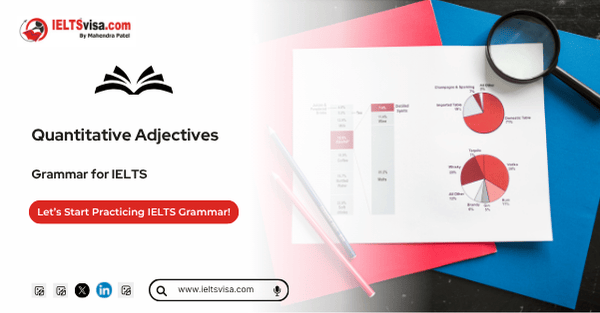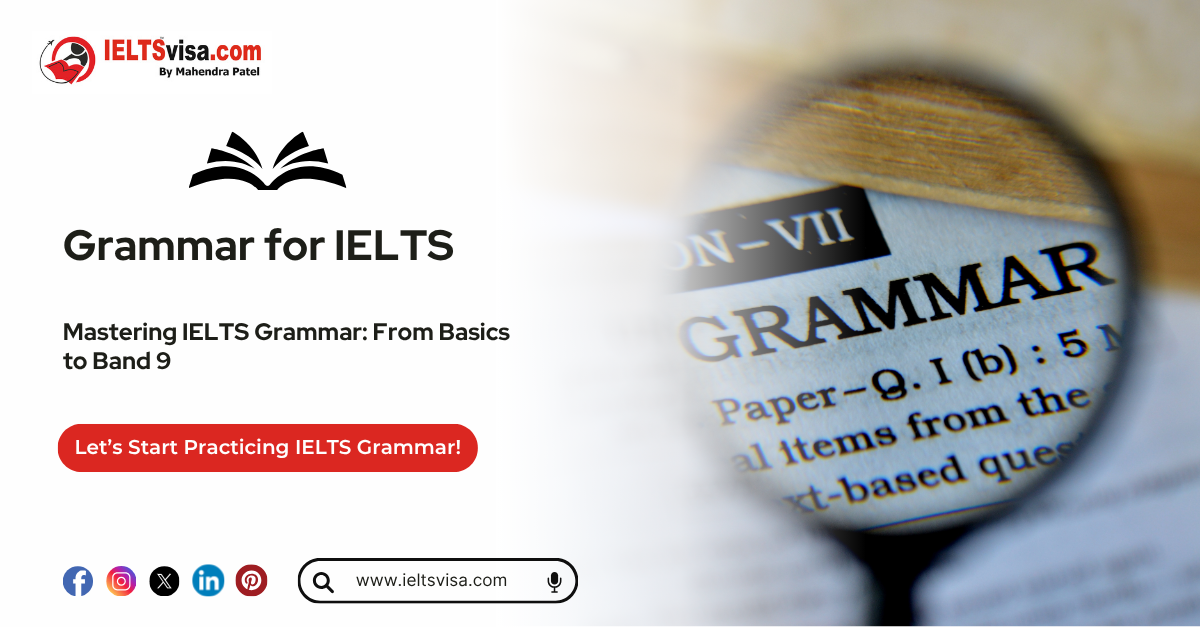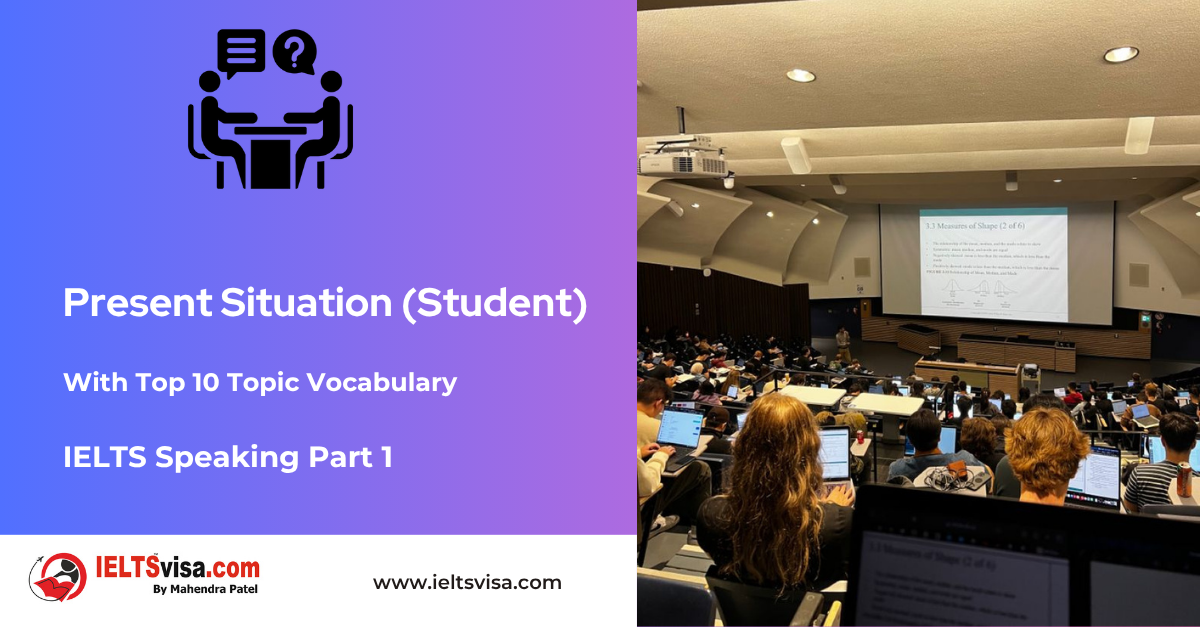Quantitative Adjectives
Grammar for IELTS

Quantitative Adjectives: Definition, Forms, Types, Usage, and Examples
In English grammar, quantitative adjectives play an important role in expressing quantity or providing information about the amount or number of a noun. These adjectives help answer questions such as “how much?” or “how many?” and are essential for adding clarity and precision to your sentences. Let’s explore the definition, types, usage, and examples of quantitative adjectives in detail.
What Is a Quantitative Adjective?
A quantitative adjective is an adjective that describes the quantity or number of a noun. It provides specific or general information about how much or how many of something exist. Quantitative adjectives modify nouns and pronouns by indicating quantity.
Types of Quantitative Adjectives
Quantitative adjectives can be broadly categorized into two types:
1. Definite Quantitative Adjectives
These adjectives express an exact or specific number or amount.
Examples of Definite Quantitative Adjectives:
-
- One: She owns one car.
- Two: There are two books on the table.
- Three: The child has three toys.
- Ten: We planted ten trees in the garden.
- Hundred: The store offers hundreds of choices.
- Thousand: Thousands of people attended the concert.
2. Indefinite Quantitative Adjectives
These adjectives give a general or approximate idea of quantity without specifying an exact number.
Examples of Indefinite Quantitative Adjectives:
-
- Some: Would you like some coffee?
- Any: Did you bring any snacks?
- Several: Several students participated in the event.
- Few: Only a few tickets are available.
- Many: He owns many cars.
- Much: There isn’t much sugar left.
- Most: She finished most of her homework.
- All: They ate all the cake.
How to Use Quantitative Adjectives
1. With Countable Nouns
Definite quantitative adjectives are commonly used with countable nouns, which can be singular or plural.
Examples:
-
- Two cats
- Five apples
- Three chairs
2. With Uncountable Nouns
Indefinite quantitative adjectives are often paired with uncountable nouns, which refer to substances or concepts that cannot be counted individually.
Examples:
-
- Some water
- Much rice
- A little patience
3. Placement of Quantitative Adjectives
Quantitative adjectives are generally placed before the noun they modify.
Examples:
-
- Many people attended the meeting.
- A few moments later, he arrived.
4. In Comparative and Superlative Forms
Quantitative adjectives can be used to compare amounts or quantities.
Examples:
-
- More: She needs more time to complete the project.
- Less: I drank less coffee today.
- Most: This is the most interesting book I’ve read.
- Fewest: He made the fewest mistakes in the test.
5. In Questions
Quantitative adjectives are often used in questions to inquire about the amount or number of something.
Examples:
-
- How many apples are in the basket?
- How much milk do we need?
Examples of Quantitative Adjectives in Sentences
Here are some examples to help you understand how quantitative adjectives are used:
1. Definite Quantitative Adjectives:
-
- She bought three dresses for the party.
- I have two siblings.
- We hiked for ten miles.
2. Indefinite Quantitative Adjectives:
-
- Would you like some tea?
- Several people raised their hands to volunteer.
- Few children were present at the park.
3. With Countable Nouns:
-
- There are four cats in the room.
- We need many chairs for the event.
4. With Uncountable Nouns:
-
- She added much sugar to the coffee.
- He has little hope of winning the race.
5. In Comparative and Superlative Forms:
-
- She needs more help with her homework than her sister.
- This jar has the least water in it.
Points to Remember About Quantitative Adjectives
1. Use with Noun Types:
-
- Definite quantitative adjectives are used with countable nouns.
- Indefinite quantitative adjectives are used with uncountable nouns.
2. No Agreement in Form
Quantitative adjectives remain the same regardless of the singular or plural nature of the noun they modify.3. Placement in Sentences
Quantitative adjectives usually come before the noun or noun phrase they describe.4. Express Comparisons:
Use comparative forms (e.g., more, less) and superlative forms (e.g., most, fewest) to compare quantities.Frequently Asked Questions (FAQs)
Q1: What is a quantitative adjective?
A quantitative adjective is an adjective that provides information about the amount or number of a noun or pronoun.
Q2: What is the difference between definite and indefinite quantitative adjectives?
-
- Definite quantitative adjectives specify an exact number (e.g., one, five).
- Indefinite quantitative adjectives provide a general idea of quantity (e.g., some, several).
Q3: Can quantitative adjectives be used with uncountable nouns?
Yes, indefinite quantitative adjectives like some and much are often used with uncountable nouns.
Q4: Can quantitative adjectives compare quantities?
Yes, comparative and superlative forms, such as more, fewer, most, and least, are used to compare amounts.

Our Books
Master IELTS Speaking Part 1
IELTS Writing Task 1 Book
IELTS Writing Task 2 Book
Practice IELTS Other Modules
IELTS Listening
The IELTS Listening test assesses how well you can understand spoken English in various contexts. It lasts about 30 minutes and is divided into four sections with a total of 40 questions. The listening tasks become increasingly difficult as the test progresses.
IELTS Academic Reading
The IELTS Academic Reading section assesses your ability to understand and interpret a variety of texts in academic settings. It is designed to evaluate a range of reading skills, including skimming for gist, reading for main ideas, reading for detail, understanding inferences, and recognizing a writer's opinions and arguments.
IELTS Speaking
The IELTS Speaking test assesses your ability to communicate in English on everyday topics. It lasts 11-14 minutes and consists of three parts: introduction, cue card, and a discussion based on the cue card topic.
IELTS General Reading
IELTS General Reading tests your ability to understand and interpret various types of texts. Here are some key areas and types of content you can expect to encounter in the reading section, along with tips for effective preparation.
IELTS Academic Writing Task 1
In IELTS Academic Writing Task 1, you are presented with a visual representation of information, such as graphs, charts, tables, or diagrams, and you are required to summarize, compare, or explain the data in your own words.
IELTS General Writing Task 1
In IELTS General Writing Task 1, you are required to write a letter based on a given situation. The letter can be formal, semi-formal, or informal, depending on the prompt. Here’s a breakdown of the key components to include in your letter
IELTS Academic Writing Task 2
In IELTS Academic Writing Task 2, you are required to write an essay in response to a question or topic. Here’s a guide to help you understand the essential elements of this task
IELTS Exam Tips
To succeed in the IELTS exam, practice regularly, familiarize yourself with the test format, improve your vocabulary, develop time management skills, and take mock tests to build confidence.
Grammer for IELTS
Grammar is the foundation of effective communication in English. Understanding tense usage, subject-verb agreement, and sentence structure enhances clarity and coherence in writing and speaking.
Vocabulary for IELTS
Vocabulary plays a crucial role in the IELTS (International English Language Testing System) exam, especially in the Speaking and Writing sections. Here’s an overview of why vocabulary is important and how it impacts your performance
RECENT IELTS SAMPLES QUESTIONS AND ANSWERS
IELTS Speaking Part 1 – Favourite Sujbect – Physics
IELTS Speaking Part 1 - Favourite Sujbect - Physics Q: What is your favourite subject? A: My favourite subject...
IELTS Speaking Part 1 – Present Situation (Student)
IELTS Speaking Part 1 - Present Situation (Student) Q1: Are you a student or do you work?A: I’m a full-time...
IELTS Speaking Part 1 – Present Situation – Employee – as an International Student and Social Worker
IELTS Speaking Part 1 - Present Situation - Employee - as an International Student and Social Worker Q1: Are...
IELTS Speaking Part 1 – Persent Situation – Employee- as an Electric Engineer
IELTS Speaking Part 1 - Persent Situation - Employee- as an Electric Engineer Q1: What do you do for a...
IELTS Speaking Part 1 – Persent Situation – Employee – as an Software Engineer
IELTS Speaking Part 1 - Persent Situation - Employee - as an Software Engineer Q1: What do you do for a...
IELTS Speaking Part 1 – Persent Situation – Married
IELTS Speaking Part 1 - Persent Situation - Married Q1: Are you married?A: Yes, I am married. My spouse and I...













